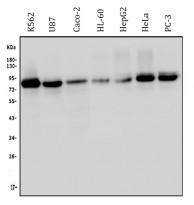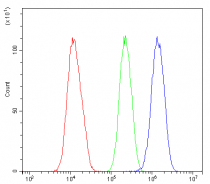ARG43231
anti-MED15 / PCQAP antibody [6F4]
anti-MED15 / PCQAP antibody [6F4] for Flow cytometry,ICC/IF,Western blot and Human
Overview
| Product Description | Mouse Monoclonal antibody [6F4] recognizes MED15 / PCQAP |
|---|---|
| Tested Reactivity | Hu |
| Tested Application | FACS, ICC/IF, WB |
| Host | Mouse |
| Clonality | Monoclonal |
| Clone | 6F4 |
| Isotype | IgG1 |
| Target Name | MED15 / PCQAP |
| Antigen Species | Human |
| Immunogen | Recombinant protein corresponding to M1-A285 of Human MED15 / PCQAP. |
| Conjugation | Un-conjugated |
| Alternate Names | Activator-recruited cofactor 105 kDa component; PC2 glutamine/Q-rich-associated protein; Mediator complex subunit 15; TPA-inducible gene 1 protein; ARC105; Positive cofactor 2 glutamine/Q-rich-associated protein; CTG7A; Trinucleotide repeat-containing gene 7 protein; Mediator of RNA polymerase II transcription subunit 15; CTG repeat protein 7a; CAG7A; TIG-1; TIG1; PCQAP; TNRC7 |
Application Instructions
| Application Suggestion |
|
||||||||
|---|---|---|---|---|---|---|---|---|---|
| Application Note | * The dilutions indicate recommended starting dilutions and the optimal dilutions or concentrations should be determined by the scientist. | ||||||||
| Observed Size | ~ 87 kDa |
Properties
| Form | Liquid |
|---|---|
| Purification | Affinity purification with immunogen. |
| Buffer | 0.2% Na2HPO4, 0.9% NaCl, 0.05% Sodium azide and 4% Trehalose. |
| Preservative | 0.05% Sodium azide |
| Stabilizer | 4% Trehalose |
| Concentration | 0.5 mg/ml |
| Storage Instruction | For continuous use, store undiluted antibody at 2-8°C for up to a week. For long-term storage, aliquot and store at -20°C or below. Storage in frost free freezers is not recommended. Avoid repeated freeze/thaw cycles. Suggest spin the vial prior to opening. The antibody solution should be gently mixed before use. |
| Note | For laboratory research only, not for drug, diagnostic or other use. |
Bioinformation
| Database Links |
Swiss-port # Q96RN5 Human Mediator of RNA polymerase II transcription subunit 15 |
|---|---|
| Gene Symbol | MED15 |
| Gene Full Name | mediator complex subunit 15 |
| Background | The protein encoded by this gene is a subunit of the multiprotein complexes PC2 and ARC/DRIP and may function as a transcriptional coactivator in RNA polymerase II transcription. This gene contains stretches of trinucleotide repeats and is located in the chromosome 22 region which is deleted in DiGeorge syndrome. Alternative splicing results in multiple transcript variants. [provided by RefSeq, Jun 2014] |
| Function | Component of the Mediator complex, a coactivator involved in the regulated transcription of nearly all RNA polymerase II-dependent genes. Mediator functions as a bridge to convey information from gene-specific regulatory proteins to the basal RNA polymerase II transcription machinery. Mediator is recruited to promoters by direct interactions with regulatory proteins and serves as a scaffold for the assembly of a functional preinitiation complex with RNA polymerase II and the general transcription factors. Required for cholesterol-dependent gene regulation. Positively regulates the Nodal signaling pathway. [UniProt] |
| Cellular Localization | Cytoplasm. Nucleus. [UniProt] |
| Calculated MW | 87 kDa |
| PTM | Ubiquitinated by TRIM11, leading to proteasomal degradation. [UniProt] |
Images (3) Click the Picture to Zoom In
-
ARG43231 anti-MED15 / PCQAP antibody [6F4] ICC/IF image
Immunofluorescence: A431 cells stained with ARG43231 anti-MED15 / PCQAP antibody [6F4] (green) at 2 µg/ml dilution, overnight at 4°C. DAPI (blue) for nuclear staining.
-
ARG43231 anti-MED15 / PCQAP antibody [6F4] WB image
Western blot: 50 µg of sample under reducing conditions. K562, U87, Caco-2, HL-60, HepG2, HeLa and PC-3 whole cell lysates stained with ARG43231 anti-MED15 / PCQAP antibody [6F4] at 0.5 µg/ml dilution, overnight at 4°C.
-
ARG43231 anti-MED15 / PCQAP antibody [6F4] FACS image
Flow Cytometry: U2OS cells were blocked with 10% normal goat serum and then stained with ARG43231 anti-MED15 / PCQAP antibody [6F4] (blue) at 1 µg/10^6 cells for 30 min at 20°C, followed by incubation with DyLight®488 labelled secondary antibody. Isotype control antibody (green) was mouse IgG (1 µg/10^6 cells) used under the same conditions. Unlabelled sample (red) was also used as a control.








